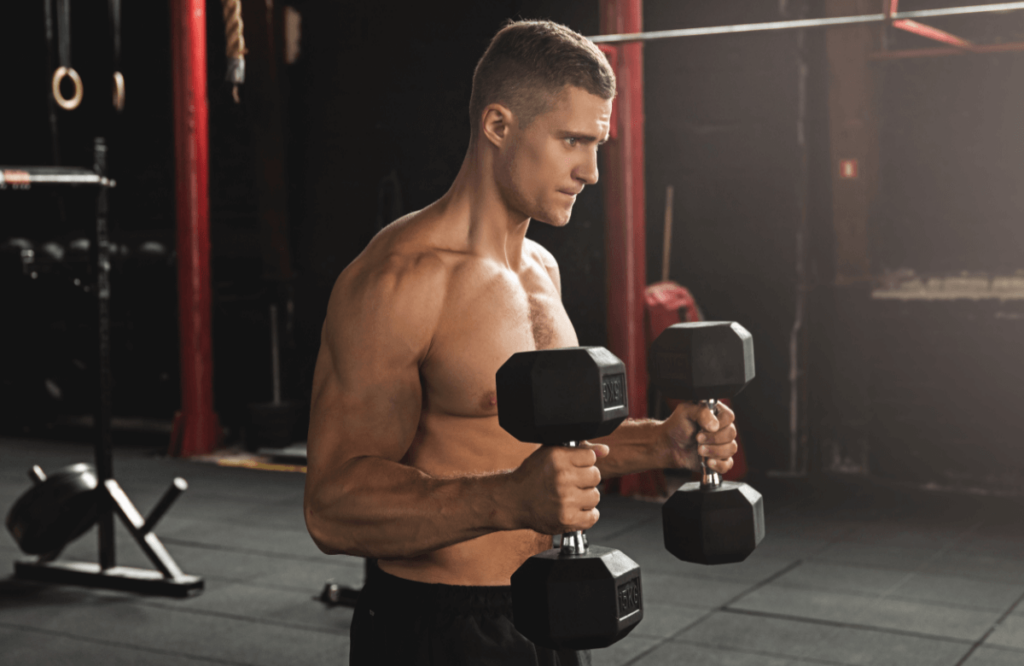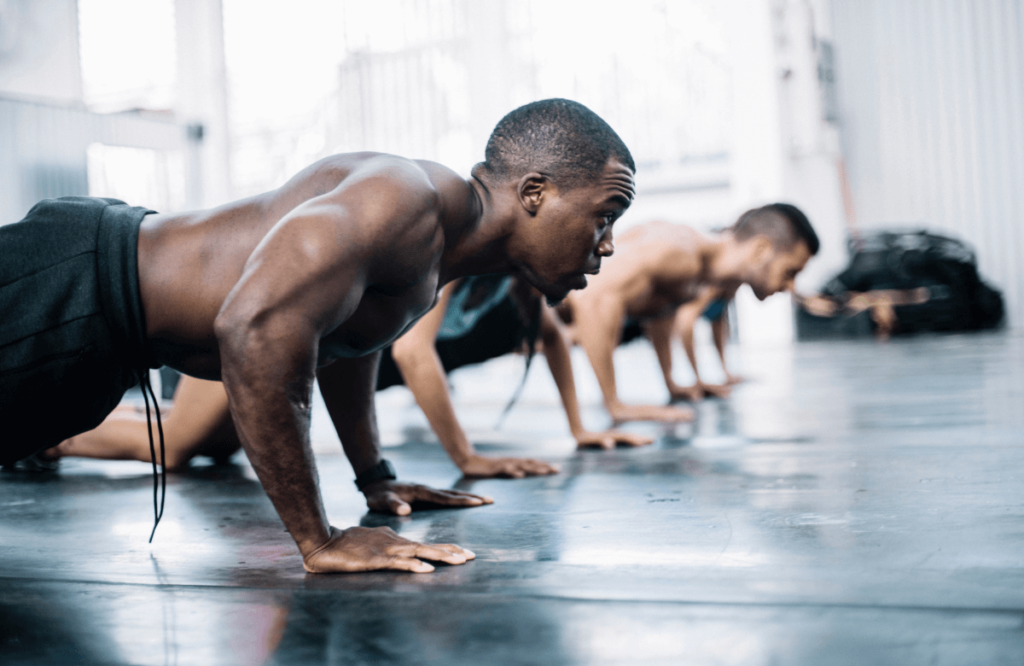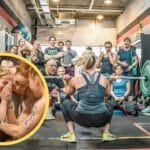Do you often feel like you’re pushing against an invisible wall in your quest for a bigger, more impressive chest?
Have you spent countless hours in the gym, pushing through grueling chest workouts? Have you tried loading up on protein, but your chest seems stuck in a perpetual state of underdevelopment?
If this sounds all too familiar, don’t, you’re not alone, and better yet, there’s help. Many fitness enthusiasts face the same hurdles when striving for chest gains. To help, we’re going to address how to build a big chest, the most common challenges, and the workout and nutrition you should aim to follow.
Jump to:
Why do people want a big chest?
When you think of iconic bodybuilders like Arnold Schwarzenegger or Dwayne “The Rock” Johnson, what’s one striking feature they share? A massive chest that exudes confidence and dominance.
A big chest is more than just attractive; it’s essential for functional strength. Your chest muscles, specifically the pectoralis major and minor, help with everyday movements like pushing, lifting, and even hugging.
A big chest can also help improve your posture. When your chest muscles are well-developed, they help to pull your shoulders back and prevent any dreaded hunching forward. This is something that many people experience due to long hours at a desk or excessive phone use.

A strong chest also contributes to overall upper body strength. It works in tandem with the shoulders, triceps, and back to help with your overall upper body strength. What this means is that you basically use your chest muscle for every kind of upper body movement, and that it connects with other muscles to help support them.
Often times, weightlifters struggle to build either a big chest or shoulders, as these muscles require some of the most attention or diverse workouts.
Which upper body muscle is the biggest: shoulder or chest?
In terms of sheer muscle mass, the chest muscles, are typically larger than the shoulder muscles.
The pectoralis major consists of three main parts:
- The clavicular head (upper chest)
- The horizontal sternal head (mid-chest)
- The vertical sternal head (lower chest)
When you train these properly, you can add considerable size and definition to your upper body.
The deltoids, or shoulder muscles, are responsible for the broadness of your shoulders. They also consist of three parts:
- The anterior (front)
- Lateral (side)
- Posterior (rear) deltoids
While they might not be as massive as the chest, well-developed deltoids contribute to a V-shape.
How do muscles grow bigger?
The science behind muscle growth is fascinating and will help in your quest for a huge chest.
Here’s a quick breakdown of how your muscles grow:
- During your workout, you subject your muscles to stress and create tiny tears and damage.
- Your body springs into action and repairs these damaged muscle fibers.
- To mend the damaged muscle fibers, your body initiates a process called protein synthesis. It fuses the damaged fibers to form new muscle protein strands, known as myofibrils.
- As these myofibrils are repaired and grow, your muscles increase in both thickness and number. This is what we call muscle hypertrophy – the growth of muscle or the layering of more myofibrils.
- Optimal muscle growth occurs when the rate of muscle protein synthesis (building) surpasses the rate of muscle protein breakdown (destruction). To do this you need to rest, recover, fuel and challenge your body properly.
All this means that muscle growth doesn’t transpire during an intense gym session. Instead, it happens after that when you rest and recover properly.

What factors contribute to a big chest?
As you can see, building a big chest requires more than just weightlifting and prayers. There are three key factors that work in harmony to help build big pec muscles.
Nutrition for muscle growth
Nutrition is necessary to support muscle growth, including chest development. To support muscle growth, you need to make sure you’re taking in enough calories to fuel your workouts and muscle recovery. More calories mean more mass, but it’s essential to strike a balance so that you don’t add too much fat.
Aim for a modest surplus of around 300–500 calories per day. This surplus gives you enough energy to fuel your workouts and support muscle growth without gaining excessive body fat.
Image: https://www.canva.com/photos/MADacpgJ3hM-foods-for-building-muscles/
Also make sure to add ample protein to your diet, as it gives the necessary amino acids for muscle repair and growth. Aim for about 1.8 to 2.2 grams of protein per kilo of bodyweight per day is a good way to up your lean body mass without affecting your body weight.
Here’s an example of what you should eat the most for chest development:
- Lean proteins like chicken, turkey, lean beef, fish, and tofu
- Complex carbohydrates like brown rice, sweet potatoes, and whole grains
- Healthy fats from sources like avocados, nuts, and olive oil
- A variety of fruits and vegetables for essential vitamins and minerals
Exercise and training for muscle growth
Next, you need to put a proverbial “bullseye on the pectoral muscles” and use different chest-specific workouts to really target those pecs. Bench press, incline bench press, dumbbell flies, dumbell press, and cable crossovers are your allies in this mission.
Your chest is a smart muscle group that adapts over time. To keep it growing, you’ll need to introduce variety into your workouts. You’ll also need to increase the weight or resistance you use during your workouts to create a progressive overload. This challenges all your chest muscles and creates bigger tears for them to grow from.
Proper form is essential to prevent injury and maximize chest muscle engagement. Make sure you’re lifting with control and using the correct range of motion.
Recovery for muscle growth
Remember that your (chest) muscles repair and grow during periods of rest. Make sure to get enough sleep, as this is when your body repairs and grows the most.
During deep slumber, your body releases growth hormones that promote muscle repair and growth. This is when your body takes amino acids from your diet and forms new muscle protein strands (myofibrils). Aim for 7–9 hours of deep sleep each night to support your chest gains.
Overtraining can slow down your muscle growth and increase the risk of injury. Make space for rest days with your workout routine to let your body rest properly.
Pay attention to how your chest muscles feel. If they are still sore or fatigued after a workout, it’s a sign they need more time to recover. On the other hand, if you feel fully recovered, you may not need as many rest days. Generally speaking, advanced lifters need less time to recover than starting lifters, since their muscles recover faster and are used to hypertrophy.
Common challenges and solutions for growing a big chest
Many people face challenges when training and working for a bigger chest. For you to avoid this, we’ll quickly go over the common ones and solutions.
Most common mistakes
One of the biggest errors is improper training techniques. Rushing through exercises with bad form not only limits muscle engagement but also increases the risk of injury. Always prioritize proper form, control, and a full range of motion during your chest workouts.

Another one is a bad diet. Some people consume excessive calories, which can lead to unwanted fat gain, while others don’t eat enough to support muscle growth.
Overtraining is another frequent mistake. If you train too often without adequate rest, it can cause you to burnout, slow progress, and even hurt yourself.
How many times should I train chest a week?
The frequency of chest training sessions depends on your fitness level and goals.
If you’re just starting, aim to train your chest once a week. This lets your muscles adapt to the new workload and recover adequately. As you progress, you can start to train your chest twice a week. Split your workouts to focus on different chest muscle groups, like upper and lower chest, during separate sessions.
Advanced lifters can train their chest three to four times a week, using various exercises and intensities. Adjust your training frequency based on your progress and recovery capacity for the best results.
Will push-ups build a big chest? (+ How to use them to build a big chest)
There’s a common myth that push ups won’t help you get a muscular chest and that only bench pressing and other workouts using weights are the way to go. A full weightlifting schedule and strong diet will definitely get you to size faster than push-ups will because you can overload your muscles more than with bodyweight.
However, you can definitely get a big chest from doing push-ups and the different variations of this great body weight push exercise.
Push-ups engage your entire chest muscles, particularly the pec major. When you lower your body towards the ground and push it back up, you’re essentially pushing against resistance, using your body as the weight.

To maximize chest engagement during push-ups, use proper form. Start in a strong plank position with your hands slightly wider than shoulder-width apart and your arms parallel to each other. As you lower your body, keep your elbows at a 45-degree angle to your torso, not flaring out wide. Then push back up to the strong plank position.
Variations of push-ups can also help immensely, and there are tons of different options. Incline push-ups, is where your hands are elevated, and this targets the upper chest, while decline push-ups with your legs raised target the lower chest. Decline push ups are also a great way to increase the difficulty of your push ups as you are using more of your body weight as resistance; this equals more weight. You can keep raising your legs onto higher objects to increase the difficulty over time.
Volume matters when it comes to chest development through regular push-ups. Gradually increase the number of push-ups you do per session to create a progressive overload. Start with a manageable number and add a few more each week to challenge your chest muscles.
For optimal results, consider incorporating push-ups into a well-rounded chest workout routine that includes other chest-specific exercises like bench presses and dumbbell flies.
Why is chest so hard to build?
There’s sometimes a tendency to overlook proper form and technique when doing chest workouts. Without the right form, your chest can’t muscles engage fully and that can limit their growth potential. To overcome this, master the correct form before you pack on weights or sets.
Another factor is muscle adaptation. As we said, chest muscles can quickly adapt to the same exercises. Incorporate different exercises, angles, and resistance levels to continually challenge your chest muscles.
Genetics also come into play, as some people may have varying rates of muscle growth in different areas. This natural variation means that results can differ massively from person to person. Some people might see more growth over time, while others will need to be patient to develop a bigger chest.
How to get a big chest? The workout
Since we already went over rest and there isn’t much else to say, we are going to focus on the other two elements and explore them deeper.
Starting with; the workout.
Chest workout routine for beginners
If you are in the early stages of trying to develop a larger chest, it’s essential to establish a solid base with a workout routine that’ll teach you the fundamentals to work towards the more advanced chest workouts.
Here’s a simple routine that’ll help you get started:
- Begin with push-ups: Aim for 3 sets of 10-12 reps, and gradually increase the difficulty as you progress.
- Next, dumbbell bench press: Start with light dumbbells to get the form right. Perform 3 sets of 6-12 reps. Focus on control and proper technique so that your muscles can remember and get used to the movements. You can also try different grips like a wider grip for more difficult variations.
- Then, do incline dumbbell press: This exercise targets the upper portion of your chest more than the lower. Use light to moderate weights and do 3 sets of 8-12 reps of proper form incline presses.
- Afterward do dumbbell flyes on flat bench: Work on your chest stretch and contraction with this exercise. Do 3 sets of 6-12 reps with a weight that challenges you without compromising form. Similar to bench press, you can use incline dumbbell flyes to build more chest height at the top of the muscle.
You can mix these up and do 1 to 5 at max reps each for three sets.
Advanced chest workout routine
After you’ve gotten a good grip on the basics, you can take it to the next level with harder workouts. Add these to your schedule as they’ll help your chest growth the most:
- Barbell bench press: Start with the classic barbell bench press. This exercise helps you to lift heavier weights and provides an excellent compound movement for chest development. Aim for 3 sets of 8–10 reps, and gradually increase your bench press weight as you progress. Change this up and use the reverse-grip bench press.
- Incline barbell bench press: Again, this helps to work the upper portion of your chest. Use a moderate weight and perform 3 sets of 8–10 reps. This variation emphasizes the upper chest muscles. Same as the basic bench press use the reverse-grip incline bench press to change things up.
- Chest dips: Dips are a fantastic triceps exercise that places a lot of emphasis on your chest muscles. Use parallel bars or a dip machine and aim for 3-sets of 8-12 reps. As you get stronger, you can add weight using a weighted belt.
- Cable crossovers: These help to isolate and sculpt your chest muscles. Focus on the stretch and contraction during each repetition.
Do 3 sets of 10-12 reps with controlled movements.
As you advance, you may want to incorporate intensity techniques like drop sets, supersets, or pyramid sets into your workouts. These techniques can provide a fresh challenge for your chest muscles and stimulate further growth.
Add grip variations like the close grip bench press, overhand grip rows, and weighted dips to your routine. These movements target different angles of your chest.
Progressive overload techniques
Progressive overload, in simple terms, means gradually increasing the demand placed on your chest muscles over time.
For example, say you start bench pressing 100 pounds for 3 sets of 10 reps. Over time, your chest adapts, and that weight becomes easier to lift. To keep growing, you must make it more challenging.
Here’s 4 ways you can do that:
- Increase the weight: You can add more weight to the bar. If you were bench pressing 100 pounds, try 105 or 110 pounds.
- Pyramid sets: Pyramid sets involve gradually increasing the weight while decreasing the reps or vice versa in each set. For example, you might start with 90 pounds for 12 reps, then 100 pounds for 10 reps, and finally 110 pounds for 8 reps.
- Drop sets: Drop sets involve reducing the weight immediately after reaching muscle failure in a set. For instance, after bench pressing 120 pounds to failure, you’d drop to 100 pounds and continue. This extends the time under tension and pushes your muscles to their limits.
- Time under tension: Instead of focusing solely on weight, you can manipulate the time your muscles spend working during each set. Slow down the tempo of your repetitions – take 3-4 seconds to lower the bar during a bench press, hold for a second at the bottom, and then explode upwards.
Best chest isolation exercises for growth
To maximize your chest growth, you should use isolation exercises that focus on the pectoral muscles.
Below are some isolation exercises that you can use in combination with the compound movements from above:
- Dumbbell pullovers: Dumbbell pullovers primarily target the upper chest and serratus anterior muscles. Lie on a bench horizontally with only your upper back and shoulders on the bench, feet flat on the floor. Hold a dumbbell with both hands above your chest and lower it backward in a controlled manner. Feel the stretch in your chest and then bring the dumbbell back to the starting position. Aim for 3 sets of 10-12 reps.
- Chest squeeze press: This exercise requires a resistance band or a cable machine. Attach the band or handle to a stable anchor point at chest height. Stand facing away from the anchor, holding the band or handles in front of your chest with your elbows slightly bent. Push your hands together, squeezing your chest muscles as you extend your arms forward. Return to the starting position with control. Perform 3 sets of 10-12 reps.
- Single-arm dumbbell press: This variation of the dumbbell press focuses on each side of your chest individually. Sit on a bench with back support and hold a dumbbell in one hand at shoulder height. Press the dumbbell upward while keeping your other arm steady. Lower the dumbbell back down, and repeat. Alternate sides for each set, aiming for 3 sets of 10-12 reps per arm.
- Cross-body cable flyes: Using a cable machine, set the pulleys at the lowest position. Stand in a staggered stance, holding a handle in each hand, and bend your torso slightly forward. Pull one arm across your body while keeping your elbow slightly bent. Feel the stretch in your chest, then return to the starting position. Alternate sides and aim for 3 sets of 10-12 reps per arm.
- Machine chest press: If available, use a chest press machine for isolated chest work. Sit down, adjust the seat and handles to your preference, and push the handles forward while contracting your chest muscles. Slowly release and return to the starting position. Perform 3 sets of 10-12 reps.
How to get a big chest? The nutrition
Now that we’ve covered the chest exercises, let’s delve into the nutrition that’ll help you achieve a bigger chest.
Protein and other nutrients
Getting your diet right is the second hardest part of big chest growth. However, you need more than just protein to fuel your muscle growth, rest and workout sessions.
To fuel your chest development, include these sources in your diet:
- Lean proteins: Foods like chicken, turkey, lean beef, fish, and tofu are excellent sources of lean protein. They provide the necessary amino acids for muscle repair and growth.
- Complex carbohydrates: Alongside protein, complex carbohydrates like brown rice, sweet potatoes, and whole grains provide sustained energy for your workouts, aiding muscle recovery.
- Healthy fats: Incorporate healthy fats from sources like avocados, nuts, and olive oil. These fats support overall body function and play a role in muscle repair.
- Fruits and vegetables: A variety of fruits and vegetables provide essential vitamins and minerals, promoting overall health and aiding muscle recovery.
Pre- and post-workout nutrition
Think of your body as a high-performance vehicle; it needs the right kind of fuel to perform at its best.
Before your chest workout, aim to have a balanced meal or snack about 1 to 2 hours beforehand. This meal should include a combination of complex carbohydrates and lean protein.
Complex carbohydrates like brown rice, sweet potatoes, or whole grains are a steady source of energy. They’ll help you sustain your strength and endurance during your workout. Lean proteins like chicken, turkey, or tofu provide the necessary amino acids for muscle repair and growth.
If you’re short on time, a quick snack can also do the trick. A banana with a tablespoon of peanut butter or a protein shake with some oats can help to kickstart your workout.
After your chest workout, your muscles need proper nourishment for recovery and growth. Aim to consume a post-workout meal or snack within 30 minutes to 2 hours after exercising. This meal should be mostly protein and carbohydrates.

Nutritional supplements for chest gains
Protein powders, like whey or plant-based options, are convenient sources of protein. They can be useful if you struggle to meet your daily protein requirements through food alone.
Creatine is a naturally occurring compound that can boost muscle performance during weightlifting. Some people may experience water retention as a side effect, but this usually subsides with continued use.
BCAAs, like leucine, isoleucine, and valine, are essential amino acids known for their role in muscle protein synthesis. Taking BCAAs before or during workouts can help reduce muscle breakdown and promote recovery.
FAQs
How can I build a big chest fast?
Building a big chest quickly requires dedication and a well-structured approach. You’ll need to continually increase the weight or resistance you use during chest workouts. Combine compound movements like bench presses with isolation exercises like flyes. Aim for ample protein intake (around 1.8 to 2.2 grams per kilogram of body weight) to aid muscle repair and growth.
Which muscle is bigger: shoulder or chest?
In terms of sheer muscle mass, the chest muscles (pectoralis major) are typically larger than the shoulder muscles (deltoids). The chest consists of three main parts: the upper chest (clavicular head), mid-chest (horizontal sternal head), and lower chest (vertical sternal head). These three segments collectively contribute to the overall size of the chest.
What makes a chest bigger?
A bigger chest is the result of muscle hypertrophy, which is the growth of muscle fibers. This happens when you subject your chest muscles to stress during workouts, creating tiny tears and damage. Your body then repairs these damaged muscle fibers through a process called protein synthesis, forming new muscle protein strands called myofibrils. As these myofibrils are repaired and grow, your chest muscles increase in both thickness and number.
Why is my chest not growing?
Several factors can contribute to slow chest growth, such as:
– Using incorrect form for chest exercises
– If you’re not consuming enough calories, especially protein, your muscles may not have the necessary building blocks for growth
– Training your chest too frequently without adequate rest can lead to overtraining
– Lack of variety
– Genetics can play a role in how quickly your chest muscles grow
How do I shape my chest?
To shape your chest effectively, focus on targeted chest exercises that emphasize different areas of your pectoral muscles.
Incorporate incline bench press and incline dumbbell press to target the upper chest. Try decline bench press and decline push-ups to work the lower chest. Use grip variations like close-grip bench press and wide-grip exercises to target different angles of your chest. Include chest isolation exercises like dumbbell pullovers, chest squeeze press, single-arm dumbbell press, and cross-body cable flyes. And gradually increase resistance or weight in your chest exercises to promote muscle growth and shape development.














